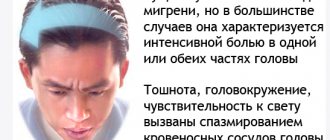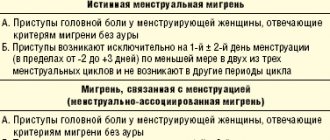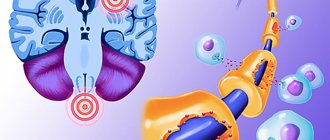Learn more about diseases starting with the letter “B”: Basilar impression, Basilar migraine, Beriberi, Bettolepsy, Amyotrophic lateral sclerosis, Alzheimer's disease, Wilson's disease, Hallerwarden-Spatz disease, Hamstorp disease, Hippel-Lindau disease, Canavan disease, Creutzfeldt disease -Jacoba, Lafora's disease, Machado-Joseph disease, Moya-moya disease, Morton's disease, Parkinson's disease, Pick's disease, Refsum's disease, Fahr's disease.
Migraine is classified into several different types of disease. One such type is basilar migraine. With this disease, various pathological changes occur in the basilar blood supply area.
Characteristic
Such a migraine is characterized directly by dizziness, ataxia, visual disturbances, hearing loss, sensory disorders, followed by an attack of headache.
This disease can be diagnosed by conducting studies such as X-rays of the brain, magnetic resonance or computed tomography of the brain, ultrasound or CT angiography of the vertebral arteries of the brain and spine, as well as by visiting a neurologist.
Pain and other disorders are relieved by inhalation of a mixture of carbon dioxide and oxygen. Prednisolone is also taken. Prevention against the disease is carried out directly in the interparoxysmal interval.
The basilar form of pathology is not as common as other types of this disease. The disease is classified as a particularly severe form, causing various complications. The blood supply to the brain is disrupted, which can lead to ischemic stroke.
Basilar migraine is distinguished by the absence of motor impairment, since similar basilar manifestations are present in familial hemiplegic migraine in most cases.
It has been noted that headaches mainly affect people aged 18 to 50 years; less often, this disease occurs in children and people whose age exceeds 50 years. In most cases, women are at risk. When diagnosed by specialists, difficulties often arise due to the various features of the manifestation of the disease.
Diagnosis of ocular migraine
Diagnosis of ocular migraine begins with collecting anamnesis, after which instrumental and physical examination methods are necessarily prescribed.
Physical examination usually includes:
- External examination of the eye.
- Assessment of the range of eye movements and pupillary response.
During instrumental examination, as a rule, the following is prescribed:
- Ophthalmoscopy.
- Determination of visual fields.
- MRI and/or CT scan of cerebral vessels.
Since ocular migraine is quite often caused by arteriovenous malformation of the brain, and its ophthalmoplegic form is provoked by an arterial saccular aneurysm in the supraclinoid region of the internal carotid artery, in case of prolonged and frequent attacks that are difficult to treat, consultation with a neurologist is recommended.
The ophthalmoplegic form of migraine must be differentiated from Tolosa-Hunt syndrome.
Causes
Experts include the following reasons for the development of the disease:
suffered stress;- high consumption of energy drinks and coffee;
- smoking;
- irregular daily routine;
- sleep disturbance, chronic lack of sleep;
- genetic predisposition;
- taking contraceptives;
- hormonal disorders;
- abnormalities of the spine;
- craniovertebral anomaly;
- instability of the spine in the cervical region.
An important and fundamental role in the occurrence of the disease is played by vasomotor and reflex disorders.
Also, most experts associate headaches with hydrops of the labyrinth (the reaction of the epithelium to constant nociceptive irritation, which causes the development of endolymphatic edema). Basilar-type researchers believe that labyrinthine involvement results in more frequent dysfunction and cochlear neuritis in people suffering from this disease. But, at the same time, hydrops can be considered a complication of migraine.
Methods for preventing attacks
To make migraine attacks less painful and to reduce their frequency, you should:
- minimize the number of stressful situations;
- walk more in the fresh air;
- include yoga, swimming, running, etc. in your regimen;
- stabilize emotional and physical stress, do not take on more than you can bear;
- establish a daily routine, pay close attention to the organization of sleep and rest.
If you experience symptoms resembling a basilar migraine, you should consult a doctor immediately.
Treatment of this type of ailment should begin as early as possible in order to avoid complications of migraine. Self-medication, in this case, is a bad friend; for a speedy recovery, it is necessary to base treatment on the recommendations of a neurologist.
Signs of illness
Symptoms for this type of disease manifest themselves as follows:
dizziness;- noise in ears;
- visual disorder consisting of double vision of visible objects;
- violation of the coordination of movements of various muscles in the absence of muscle weakness;
- hearing loss;
- speech disorders that arise due to damage to the central nervous system;
- disorder of consciousness;
- sensory disturbances;
- bilateral visual phenomena such as flashes of light and spots;
- amaurosis.
The above symptoms of the disease are transient and disappear within 10 minutes. Sometimes symptoms appear sequentially and in several types at once. The duration of symptoms is about 1 hour.
More than 50% of people suffering from this pathology have transient focal neurological deficits. Less common is a prolonged manifestation of migraine in the form of a headache, lasting about 8 hours.
After the migraine aura ends, a unilateral headache occurs, located in the occipital region and manifested by throbbing.
There is also cephalalgia, which is located not only in the occipital region. Most patients with this type of pain complain of a severe aura, which is why some patients are unable to characterize the headache. This is why it can be difficult for specialists to diagnose this type of disease.
Less than 50% of people with basilar migraine complain of nausea and vomiting, as well as photophobia. It is also noted that patients may experience fainting and unconsciousness, followed in rare cases by short-term memory loss.
The disease is stable, with paroxysms occurring every few weeks or months. It is noted that as the patient’s age increases, the duration and intensity of the manifestation of the pathology decreases.
Treatment
It is important for a person suffering from migraine pain to learn how to prevent attacks. To do this, it is advisable to keep a diary and write down your physical well-being, as well as external factors that cause its deterioration.
When it becomes clear what is causing the attack, then avoid provoking factors as much as possible.
The therapy itself consists of relieving the acute symptoms accompanying the attack.
The doctor selects a treatment regimen for each patient individually, depending on the clinical picture. Typically, beta blockers are prescribed, which normalize blood pressure and heart rate, as well as anticonvulsants.
Non-narcotic analgesics are not able to completely stop an attack; they can only temporarily alleviate the patient’s well-being at the very beginning of an attack.
A distinctive feature of basilar migraine from other types is that it cannot be treated with drugs based on sumatriptan. As an alternative, doctors prescribe Prednisone to patients suffering from basilar migraine.
Clinical Brain Institute Rating: 2/5 — 3 votes
Share article on social networks
Diagnosis
When visiting a neurologist, the patient undergoes a survey, as a result of which the specialist collects an anamnesis, on the basis of which a presumptive diagnosis is made. Basilar migraine is caused by the absence of any brain pathology, for example, intracerebral tumor, encephalitis, cerebral cyst, brain abscess, hydrocephalus. In order to exclude pathologies, the doctor prescribes an examination in the form of a spiral computed tomography or magnetic resonance imaging of the brain.
If a patient has been diagnosed with basilar migraine, this is the reason for examining the cervical spine. This examination is carried out by performing x-rays of the spine, magnetic resonance or computed tomography of the spine, ultrasound dopplerography or CT angiography of the vertebral arteries.
In order to examine the hearing aid, the patient is referred to an audiologist. Subsequently, the patient is diagnosed if there are indications for this. The examination is carried out by audiometry and electrocochleography.
In order to detect hidden spontaneous nystagmus, vestibular reactivity disorders, electrocochleographic signs of hydrops, and hearing loss in a patient, specialists prescribe studies to the patient in the form of videooculography, vestibulometry, caloric test and electronystagmography.
Experts associate this pathology with Meniere's disease, cervical migraine (posterior cervical sympathetic syndrome), vertebral artery syndrome, and transient ischemic attack.
Cervical migraine is characterized by the occurrence of focal neurological manifestations along with the headache. With cervical pain, there is no photophobia, as well as pronounced tonic tension of the cervical muscles, but there are trigger points in the cervical spine. Meniere's disease is characterized by the absence of cephalalgia and visual disturbances. With Meniere's disease, the patient complains of nausea and vomiting. With migraine, there is a headache. Also, with Meniere's disease, scotomas form, which subsequently merge.
What form of disease is this?
This is a chronic hereditary disease that manifests itself in intense, “aching” headaches localized in the occipital and temporal regions.
The disease has this name because it concerns pathological processes in the basilar artery, from which blood flows to all other parts of the body.
The attack begins suddenly.
Unlike other types of headaches that are triggered by bright lights, loud noises, etc., this type of migraine occurs without triggers.
Immediately before an attack, a person experiences an aura state - deterioration of auditory sensitivity and vision, ataxia, dizziness.
Important! The most severe consequences of an attack without timely treatment can be ischemic stroke and migraine infarction.
Migraine and vestibular dysfunction
O.G. MOROZOVA, Doctor of Medical Sciences, Professor, Head of the Department of Reflexology, Kharkov Medical Academy of Postgraduate Education
At some point in life, almost everyone experiences a headache. Despite its frequency of occurrence, headache is perceived by both healthcare professionals and society at large as a common complaint and a minor illness. Based on this, the social, economic, physical, not to mention emotional, consequences of having a headache are not sufficiently recognized in comparison with the same consequences of other, less common diseases.
Among the heterogeneous headache syndrome, migraine, which is a primary headache, occupies a special place. Described 3000 years before the birth of Christ, with its own methods of treatment in the time of Hippocrates, it remains to this day one of the most common, but not always diagnosed primary headaches. According to the International Headache Society (IHS), migraine is diagnosed in only 48% of patients who have a headache that fully meets the criteria for migraine. In addition, epidemiological studies show that among all patients with migraine, 32% were misdiagnosed as tension-type headache, and 42–50% were misdiagnosed as sinusitis.
Meanwhile, migraines affect 12% of US adults, or more than 28 million people. The same high figures are found in Europe and most countries of the world, with the exception of China, where they are significantly lower. The highest prevalence rates of migraine are observed in the most productive years of life (ages 25 to 55). 90% of migraine sufferers experience their first attack before age 40.
Migraine headache causes significant socioeconomic damage due to decreased productivity or absenteeism. The annual cost of lost productivity due to migraine ranges from $1.2 to $17.2 billion in the United States. The cost of migraine in England is estimated at almost £950 million a year. In this case, the direct costs of the health care system also seem significant. Migraine is one of the common reasons for seeking emergency medical care. According to the US National Ambulatory Health Care Service, more than 10 million doctor visits per year were made for headaches. A huge number of prescription and over-the-counter medications are prescribed to treat headaches. Every year, Americans spend about $400 million on over-the-counter pain medications.
Classification and clinical forms
Migraine is a paroxysmal condition manifested by attacks of pulsating headaches in one half of the head, mainly in the orbital-frontotemporal region, or bilateral localization. The attack is accompanied by nausea, vomiting, photo- and phonophobia. Characterized by recurrence and hereditary predisposition.
The criteria for diagnosing migraine were defined by the International Headache Society in 1988 and revised in 2004. There are two main forms of migraine: migraine without aura (simple) and migraine with aura (associated). The latter is the most common form, observed in 80% of cases. Migraine without aura is characterized by the following symptoms:
- paroxysmal headache lasting from 4 to 72 hours;
- headache has at least two of the following characteristics:
predominantly unilateral localization, alternating sides, less often bilateral;
- pulsating character;
- moderate to severe headache intensity (interferes with daily activities);
- increased during physical activity;
- nausea;
To make a diagnosis of migraine without aura, there must be a history of at least 5 attacks that meet the listed criteria. This is the most common form, observed in 80% of cases.
In migraine with aura, the pain attack is preceded by a migraine aura. An aura is a complex of focal neurological symptoms that precede an attack of pain or occur at the height of pain. The nature of clinical neurological manifestations depends on the involvement of the carotid or vertebrobasilar vascular system in the pathological process.
Migraine with aura is characterized by complete reversibility of aura symptoms; the duration of the aura is no more than 60 minutes; The duration of the light interval between the aura and headache should also be no more than 60 minutes. To be diagnosed with migraine with aura, the patient must have had at least 2 attacks that meet these criteria.
The greatest difficulties arise in the differential diagnosis of migraine aura with transient ischemic attacks. The frequency of migraine aura, its temporal characteristics, combination with typical migraine headaches and family history of migraine are of utmost importance.
Migraine with aura is much less common than migraine without aura (20%). Depending on the nature of the focal neurological symptoms that occur during the aura, several forms are distinguished: ophthalmic, retinal, ophthalmoplegic, hemiparetic, aphasic, cerebellar, vestibular, basilar or syncope. More often than others, the ophthalmic form occurs, which is characterized by flashing bright photopsies in the right or left field of vision, possibly with their subsequent loss. In childhood, benign dizziness is identified as the equivalent of migraine.
To understand adequate therapeutic tactics at the time of migraine paroxysm, it is necessary to take into account the presence of three phases in its course. The first phase - prodromal (in 50-70%) - occurs in all forms of migraine in the form of changes in the emotional state, performance, etc. In migraine with aura, the manifestations depend on the type of aura that is associated with the vascular system. The second phase is headache with all its features and accompanying symptoms. The third phase is characterized by a decrease in headaches, lethargy, fatigue, and drowsiness. Some patients experience emotional activation and euphoria.
Provoking factors
Migraine is a hereditary disease, the course of which (the frequency and intensity of attacks) is influenced by a number of different external and internal factors.
Patients with migraine often report increased sensitivity to weather conditions, and changes in weather conditions can provoke a migraine attack in them. Physical activity, especially extreme physical activity and combined with emotional stress, is also a provocateur of migraine. Eating irregularly (fasting) or eating certain foods can trigger a painful migraine attack in migraine sufferers. Approximately 25% of patients associate the occurrence of an attack with eating food rich in tyramine (cocoa, chocolate, nuts, citrus fruits, cheese, smoked meats, etc.). The amino acid tyramine binds to the enzyme monoamine oxidase (MAO) and causes changes in vascular tone (angiospasm). In addition, tyramine competes with the serotonin precursor tryptophan, preventing its entry into neurons and thus reducing the synthesis of serotonin in the central nervous system. Provocateurs of a migraine attack are also alcohol (especially red wine, beer, champagne) and smoking.
Migraine attacks increase the frequency of deviations from the usual sleep pattern. The trigger can be either lack of sleep or excessive sleep. Patients who manage to fall asleep during an attack relieve headaches in this way.
Pathogenesis of migraine
The pathogenesis of migraine is extremely complex, and many of its mechanisms are not fully understood. Modern researchers believe that cerebral mechanisms are leading in the occurrence of a migraine attack. In patients with migraine, it is assumed that there is a genetically determined limbic-stem dysfunction, leading to a change in the relationship between the anti- and nociceptive systems with a decrease in the influence of the latter. Before an attack, there is an increase in the level of brain activation followed by a decrease during a painful attack. At the same time, the trigeminovascular system is activated on one side or the other, which determines the hemicranial nature of the pain. In the perivascular endings of the trigeminal nerve, when activated, vasoactive substances are released: substance P, calcitonin, causing a sharp dilation of blood vessels, impaired permeability of the vascular wall and initiating the process of neurogenic inflammation (release of nociceptive substances into the perivascular space from the vascular bed: prostaglandins, bradykinins, histamine, serotonin and etc.). Serotonin plays a special role in the pathogenesis of migraine. Before an attack, platelet aggregation increases, serotonin is released from them, which leads to a narrowing of large arteries and veins and dilation of capillaries (the most important factor in the development of the 1st phase of an attack). Subsequently, due to the intensive release of serotonin by the kidneys, its content in the blood decreases, which, together with other factors, causes dilatation and atony of blood vessels. Migraine pain, therefore, is a consequence of excitation of the afferent fibers of the trigeminal nerve as a result of the release of a number of biologically active nociceptive substances involved in the formation of neurogenic inflammation. This process is cyclical, in its genesis the leading role belongs to cerebral mechanisms.
Clinical and pathogenetic relationship between migraine cephalgia and dizziness
The connection between migraine and vestibular dysfunction is of great interest for practical activities and adequate therapy. On the one hand, vestibular disorders are closely intertwined with the clinical picture of migraine paroxysm. Moreover, there are forms of migraine where vestibular disorders play a leading role in clinical manifestations (vestibular, basilar, cervical), and sometimes are the only ones (benign dizziness in children), being the equivalent of migraine paroxysm. This indicates, in addition, the commonality of the pathogenetic mechanisms leading to migraine and vestibular paroxysms relating to histamine and histamine receptors. As already mentioned, histamine is released during migraine as a result of neurogenic inflammation, namely in the second and third phases of the attack. In turn, the pathogenesis of vestibular dysfunction is associated with the activation of histamine receptors located in the brain, mainly in the hypothalamic region, labyrinth, cerebellum and brainstem, as well as with deterioration of blood flow in the inner ear and in the area of the vestibular nuclei. Obviously, this is why there is a vicious circle of cause-and-effect relationships that determine either the presence of an aura in the form of vestibular dysfunction, or dizziness as a consequence of an already developed migraine attack. And in the interictal period, there are either more frequent cases of vestibular disorders in patients with migraine compared to the population, or, conversely, a higher frequency of migraine paroxysms in people with vestibular dysfunction. It is precisely because of the commonality of some pathogenetic mechanisms that there is a close relationship between vestibular and autonomic dysfunction, against the background of which migraine often develops.
Thus, 70% of migraine patients complain of dizziness of various types, occurring both during a migraine attack and during the inter-attack period of the disease, and 50% show symptoms of damage to the labyrinth and disturbances during vestibular tests. Cochleovestibular symptoms are most pronounced in the basilar form of migraine, which occurs mainly in adolescents and young women. In most cases, a headache attack is preceded by systemic dizziness, ataxia, nystagmus and tinnitus, which can last from several minutes to an hour. In severe attacks, bilateral blindness, alternating hemiparesis or tetraparesis, oculomotor disorders, diplopia, and vomiting may develop. The peculiarity of basilar migraine is that the neurological symptoms of aura can persist in the phase of headache, which suddenly appears in the occipital region, has a strong pulsating nature and can be accompanied by a short-term loss of consciousness. It is believed that the focal neurological symptoms of aura in basilar migraine are based on deterioration of blood circulation in the vertebrobasilar arteries. Severe variants of basilar migraine should be considered as a complicated form of migraine. Observation of such patients shows that with age, basilar migraine transforms into less severe forms of the disease.
Vestibular disorders of a peripheral and central nature are observed not only in basilar, but also in vestibular, ophthalmic, hemiplegic, aphasic and other forms of migraine with aura. In addition, dizziness often occurs during migraine attacks without aura.
Of particular interest are cases of so-called “decapitated” migraine, or, according to the international classification, migraine aura without headache. An attack of this form of migraine is characterized by the presence of local, most often visual and vestibular, disorders without subsequent headache. Dizziness can be peripheral or central in nature and accompanied by pyramidal and sensory symptoms. The diagnosis of this form of migraine is probabilistic and requires the exclusion of organic brain diseases, which can manifest as vestibular and cochlear symptoms. Correct diagnosis of migraine aura without headache is helped by hereditary history, age, cyclical nature of attacks, cases of migraine headache, complete regression of symptoms after an attack, further transformation of “decapitated” migraine into one of the typical forms of migraine with or without aura, as well as the absence changes during laboratory and instrumental examination.
The clinical picture of migraine in childhood has its own characteristics. Migraine in children, along with typical attacks, can manifest itself in the form of so-called migraine equivalents, or, according to the modern classification, headaches of periodic syndromes of childhood. These types of syndromes may be precursors to or associated with migraine. The most common equivalent of migraine in children is recurrent benign paroxysmal vertigo. This syndrome is characterized by the occurrence, against a background of complete health, of short-term attacks of imbalance, systemic dizziness, anxiety, spontaneous nystagmus and vomiting. A neurological examination and additional instrumental studies do not reveal pathological changes in the nervous system or labyrinth in children. With age, in the absence of adequate therapy, attacks acquire the typical features of migraine with headache.
Dizziness and ataxia are very common symptoms of an attack of so-called cervical migraine (Barré-Lieu syndrome, posterior cervical sympathetic syndrome). For the first time M.J. Barre (1925) described a symptom complex of headache, visual, auditory and vestibular disorders in patients with osteochondrosis and spondylosis of the cervical spine. The similarity of the clinical picture of posterior cervical sympathetic syndrome with migraine allowed us to call it cervical migraine. An attack of cervical migraine can be triggered by a sharp turn of the head or long-term tension in the muscles of the neck and back of the head. Dull, bursting, less often pulsating pain appears in the cervical-occipital region, and then spreads to the entire half of the head and the orbital region. The side of hemicranial irradiation of pain usually corresponds to the side of cervico-occipital pain. Headache is accompanied by dizziness, noise and ringing in the ears, blurred vision, and sometimes fainting. The duration of the attack can range from 30 seconds to several hours. According to most authors, an attack of cervical migraine occurs as a result of irritation of the sympathetic plexus of the vertebral artery by osteophytes of the uncovertebral joints in individuals with degenerative-dystrophic changes in the cervical spine. In some cases, the pain syndrome is not pronounced and the symptoms of circulatory disorders in the vertebrobasilar region come to the fore - cochleovestibular, visual and other focal symptoms.
Diagnosis of cervical migraine is based on a thorough study of the profile of the headache, the factors that provoke its occurrence, data from a neurological examination and additional X-ray diagnostic methods for studying the cervical spine and craniovertebral region. Differential diagnosis with true migraine is not difficult in most cases. Cervical migraine is the result of the impact of pathological bone and cartilage structures on the vertebral artery and its sympathetic plexus. The most common cause of this effect is osteochondrosis of the cervical spine, namely the first and second cervical vertebrae. Also, irritation may not occur as a result of osteochondrosis, but as a result of an injury, for example, whiplash, during sudden braking of a car, etc. The vertebral artery ultimately supplies the occipital and posterior temporal lobes, the cerebellum, and the structures of the inner ear. Therefore, compression of the artery or irritation of its sympathetic plexus causes a reflex spasm of other intracerebral vessels, leading to insufficient blood supply to the same areas that are affected by hemicrania. Hence the great similarity in external manifestations. Thus, with cervical migraine, pain syndrome is observed (burning pain in the back of the head, temple, and sometimes in the superciliary region), visual disturbances (pain and feeling of sand in the eyes, fog before the eyes), vestibular manifestations (dizziness, noise and crackling in the ears, hearing loss).
It is often very simple to distinguish cervical migraine from true hemicrania: it is necessary to additionally press the vertebral artery (create artificial compression) at a point on the border of the middle and outer third of the line connecting the mastoid process and the spinous process of the first cervical vertebra. If pressing on the vertebral artery at this point provokes or intensifies pain, this is a cervical migraine.
During the interictal period of the disease, 50% of patients with migraine with aura and 46% of patients with migraine without aura exhibit neurological and otological symptoms, indicating the non-random nature of the combination of migraine and vestibular disorders. It was found that in patients with migraine, benign paroxysmal vertigo, Meniere's disease and vestibular dysfunctions, identified in the study of spontaneous and evoked vestibular reactions, were significantly more common than in the control group. A number of authors express the opinion that there is a hereditary and pathogenetic connection between Meniere's syndrome and paroxysmal benign vertigo in children and adults with migraine. IN AND. Babiyak et al. (1996) believe that Meniere's disease can, with certain assumptions, be classified as a special case of migraine, namely labyrinthine migraine with symptoms of its glaucoma.
Principles of treatment for migraine with vestibular dysfunction
Based on the commonality of some pathogenetic links of migraine and vestibular dysfunction, treatment of vestibular disorders in patients with migraine is an integral part of a complex of therapeutic measures carried out for this disease, and can be carried out both during an attack and prophylactically during the interictal period of the disease. The main principles of migraine treatment are modification of the lifestyle of patients in order to eliminate the causes that provoke attacks of the disease, and drug therapy.
Traditionally, migraine therapy consists of attack relief and preventive therapy.
To relieve migraine attacks, 3 groups of drugs are used.
1st group. For mild to moderately intense attacks, paracetamol, acetylsalicylic acid (ASA) and its derivatives, as well as combination drugs, can be effective. The action of this group of drugs is aimed at reducing neurogenic inflammation, suppressing the synthesis of pain modulators (prostaglandins, kinins, etc.), and activating antinociceptive mechanisms of the brain stem. When using them, it is necessary to remember about contraindications to the use of ASA (presence of diseases of the gastrointestinal tract, tendency to bleeding, hypersensitivity to salicylates, allergies), as well as the possibility of developing abuse headaches with prolonged and uncontrolled use of these drugs.
2nd group. Dihydroergotamine drugs have a powerful vasoconstrictor effect due to their effect on serotonin receptors localized in the vascular wall, prevent neurogenic inflammation and thereby stop a migraine attack. Dihydroergotamine is a non-selective serotonin agonist and also has dopaminergic and adrenergic effects. In case of overdose or hypersensitivity to ergotamine drugs, chest pain, pain and paresthesia in the extremities, vomiting, diarrhea (phenomena of ergotism) are possible.
3rd group. Selective serotonin agonists (triptans), which have a selective effect on serotonin receptors in the brain, are currently considered the most effective and safe drugs for the treatment of migraine. Triptans prevent the release of substance P from the trigeminal nerve endings and neurogenic inflammation.
It should be noted that our experience with the use of triptans (Sumamigren at a dose of 50 or 100 mg) has shown that stopping an attack in the early phase of migraine paroxysm can prevent the development of vestibular symptoms if they are a consequence of the development of neurogenic inflammation.
It is assumed that the cause of peripheral and central dizziness during migraine is, in addition, deterioration of labyrinthine and cerebral circulation. Therefore, to treat dizziness and related disorders, you can use drugs that improve blood circulation in the vertebobasilar arteries and their branches, without affecting blood circulation in other vessels.
A drug that can improve blood circulation in the vertebrobasilar arteries and their branches (posterior, posterior cerebellar, internal auditory, etc.), while not affecting blood circulation in other vessels and blocking histamine receptors, can be considered optimal for the treatment of dizziness. Experimental results from Takeda et al. (1993) showed the special role of histamine in the functioning of the vestibular pathways and the regulation of vascular tone in the vertebrobasilar region. The clinical effect of one of the most effective drugs for the treatment of dizziness, betahistine (the drug Betaserc), is based on the selective improvement of regional blood circulation in the labyrinth and basin of the basilar artery without a significant effect on systemic blood pressure (EA Laurikainen, JM Miller, WS Quirk et al., 1993 ). The neuronal mechanism of action of betahistine is associated with the normalization of neuromediation processes in histaminergic neurons of the vestibular nuclei, which determine the central mechanisms of dizziness (H. Timmerman, 1994, PB Van Cauwenberge, SEG De Moor, 1997). And given the fact that these groups of receptors are also located in the hypothalamus, the functional state of which is closely related to migraine, blocking the corresponding receptors can also help reduce migraine paroxysms.
Thus, the modern approach to the treatment of vestibular disorders in migraine involves the use of a complex of non-drug and pharmacological interventions aimed at both stopping an already developed attack of migraine and dizziness, and at their prevention. There is no doubt about the need to include the most effective vertigolytic drugs in the treatment regimen for patients suffering from migraine and dizziness.
Our experience of using Betaserc 24 mg twice a day in patients with dizziness in the structure of migraine paroxysms and in the interictal period for 3 months showed either a decrease in its severity or disappearance at the time of the attack itself. But the most valuable, in our opinion, was the reduction in the frequency of migraine paroxysms, which primarily concerned patients with vestibular, basilar and cervical migraine. This situation requires further study of other forms of migraine, in the structure of clinical manifestations of which there are vestibular manifestations, since there are pathogenetic justifications for this.
Thus, the modern approach to the treatment of vestibular disorders in migraine involves the use of a complex of non-drug and pharmacological interventions aimed at both stopping an already developed attack of migraine and dizziness, and at their prevention. On the one hand, stopping migraine paroxysm (triptans) will help reduce the likelihood of vestibular manifestations. On the other hand, there is no doubt about the inclusion of betahistine (Betaserc) in the treatment regimen for patients suffering from migraines and dizziness. This therapeutic approach will improve the effectiveness of therapy and will contribute to the prevention of migraine attacks.
Literature 1. Amelin A.V., Ignatov Yu.D., Skoromets A.L. Migraine. - St. Petersburg: Med. publishing house, 2001. - 200 p. 2. Babiyak V.I., Lantsov A.A., Bazarov V.G. Clinical vestibulology. - St. Petersburg: Hippocrates, 1996. - 336 p. 3. Migraine / A.M. Wayne, O.A. Kolosova, N.A. Yakovlev, T.A. Slyusar. - M., 1995. - 180 p. 4. Kadykov A.S., Shakhparonova N.V., Manvelov N.S. Headache Guide. - M.: Milkosh, 2005. - 170 p. 5. Polushkina E.A. Discirculatory vertebrogenic vestibular dysfunction // Vascular diseases of the brain and spinal cord / Ed. prof. A.Yu. Savchenko. - Omsk: Omsk State Pedagogical University Publishing House, 2000. 6. Shtok V.N. Headache. - M.: Medicine, 1987. - 304 p. 7. Aanta E. Treatment of acute vestibular vertigo // Acta Otolaryngol. (Stockh). - 1991. - Suppl. 479. - P. 44-47. 8. Cass SP, Ankerstjerne K., Balaban C., Yetister S., Aydogan B. Migraine-related vestibulopathy // Ann. Otol. Rhinol. Laryngol. - 1997. - No. 106 (3). — P. 182-189. 9. Classification and Diagnostic Criteria for Headache Disorders, Cranial Neuralgias and Facial Pain, International Headache Society, Cephalalgia. - 1988. - Vol. 8. - Suppl. 7. 10. Goadsby PJ Pathophysiology of Migraine: A Disease of the Brain // Headache / PJ Goadsby, SD Silberstein (eds). - Butterworth-Heinemann, 1997. - P. 5-25. 11. Gordon CR, Kuritsky A., Doweck I., Spitzer O., Shupak A., Hering R. Verstibulo-ocular reflex in migraine patients: the effect of sodium valproate // Headache. - 1993. - No. 33 (3). — P. 29-32. 12. Rasmussen BK Epidemiology of migraine // Towards Migraine 2000 / F. Clifford Rose (eds). - Elsevier Science, 1996. - P. 1-15. 13. Steward WF, Lipton RB Migrain Epidemiology in the United States // Headache Classification and Epidemiology / J. Olesen (eds). - New York: Raven Press, 1994. - P. 239-247. 14. Szirmai A. Vestibular disorders in patients with migraine // Eur. Arch. Otorhinolaryngol. Suppl. - 1997. - No. 1. - S. 55-7. 15. Takeda N., Morita M., Hesagawa S., Horii A., Kubo T., Matsunaga T. Neuropharmacology of motion sickness and emesis. Acta Otolaryngol. (Stockh). - 1993. - Suppl. 501. - P. 10-15. 16. Timmerman H. Pharmacotherapy of vertigo: any news to be expected? // Acta Otolaryngol. (Stockh). - 1994. - Suppl. 513. - P. 28-32.










